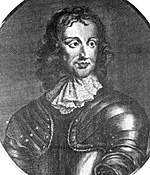
General John Lambert (at right) had not been one of the Regicides (i.e. not one of those who signed the King's Death Warrant), but his prominance during the Inter-Regnum made him too dangerous a man to leave at liberty after the Restoration. After narrowly escaping sentance of death for High Treason, he was imprisoned at Castle Cornet on Guernsey, one of the Channel Islands.
Lambert's main interests in captivity
were recorded as study, gardening and
painting and, by a fortunate chance, a list of
part of his library survives. This list, in
Lambert's own handwriting, is dated February
1667 and so dates from the period of his
captivity. Of the 45 books listed (1) the
majority are on theology or otherwise related
to Religion, and only four are strictly military
works. These were:
The books a man takes with him to study
in captivity or exile reflect his real interests, in
much the same way as a choice of "Desert
Island Discs", and this list gives a particular
insight into Lambert's favourite military
books.
Flavius Josephus' was the first century
A.D. author of "The Jewish War", a
panegyric of the Emperor's Titus'
Suppression of the Jewish Revolt. Josephus
had originally been one of the rebels. His
work was highly regarded by Johann of
Nassau, (2) regarded by many as one of the
principal architects of the Dutch military
reforms. The value of Josephus for readers
Such as Johann of Nassau or John Lambert
was its description of Roman military
practices.
Claudius Aelianus was a second
century A.D. military writer whose work on
tactics was highly valued by Prince Maurice
of Nassau (3) who used it as the basis of the
training manuals developed for his reformed
Dutch Army. Its English translator, John
Bingham, commented that its particular value
over works of other classical writers was that
"it hath beene the manner of those writers for
the most part, to applie their stile not to the
ignorant, but to such as are already acquainted
with the matters they intreat of". Aelian's
work had the advantage that he explained the
basis of classical tactics simply enough that it
could be understood by a novice. Since those
with the practical experience to explain
classical tactics were long dead, only Aelian's
work could provide Prince Maurice with the
information he required to recreate it.
As the training of English Militia
troops was based on the Dutch model, John
Bingham's translation was one of the most
important English military works in use
before the Civil War.
William Barriffe's work was the
foremost of the military books developed on
the Dutch model for the use of the English
Militia and became the most popular of all
those in use during the Civil War itself.
The last two works, Bingham's
translation of Aelian and William Barriffe's,
were significant works of English military
theory used to train Militia soldiers before the
Civil War, and in Barriffe's case, used by
regular soldiers during it as well. Their
inclusion amongst the books Lambert chose
for his exile provides a connection between
the English military theory developed before
the Civil War and one of the leading military
figures of the New Model Army. An
indication that officers like Lambert, who had
no military experience before the Civil War,
saw the manuals produced for the prc-war
Militia as having practical value for actual
service.
(Ed. Well there you have it, John
Lambert, "Cromwell's Understudy", a fan of
Barriffe's. If he was, Shouldn't you be ?)
(1) The full list of John
Lambert's library, can be found in W H Dawson Cromwell's
Understanding the Life and Times of General John Lambert
London 1938.
(2) A manuscript list of the
Principal authors favoured by Johann of Nassau Survives in
the Hessisches Haupstaatsarchiv, Wiesbaden. K924 Bl 36r. It
includes both Flavius Josephus and Claudius Aelianus.
(3) Aelian's work was used
as the literal base of the instruction manuals drawn up for the Dutch Army. The basic instruction, To the right hand, to the left hand etc, were literal translations from the
original Greek text.
This article appears in MagWeb (Magazine Web) on the Internet World Wide Web.Notes
Back to English Civil War Times No. 45 Table of Contents
Back to English Civil War Times List of Issues
Back to Master Magazine List
© Copyright 1992 by Partizan Press
Other military history articles and gaming articles are available at http://www.magweb.com